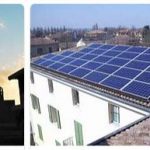Other formations in the area are pastures and arid and dripping cliffs, and groundwater debris, etc., but the exemplification of their most characteristic and endemic species would be too long.
Above the vast and gloomy tree belt, interrupted by meadows and rocky slopes, a consortium of gregarious shrubs is very developed in the Alps, many of which transmigrated from the underlying forests and which characterize better than others the subalpine area that some old botanist designated with name of the area of the mountain pines from the abundance of Pinus mugo (= P. montana ) which covers especially the Dolomite cliffs, which is associated with a dwarf and prostrate form of the common juniper ( Jun . montana ), several Ericaceae, some willows with stems adhering to the soil and small leaves that also rise to the next area ( Salix herbacea , reticulata , retusa ), the Empetrum nigrum , etc. Traces of it can be found in the northern Apennines: the dwarf juniper and its congener, the J. hemisphaerica , the Daphne glandulosa , a breed of mountain mountain ( P. pumilio ) are to remember it in the central together with the beech that becomes bushy and twisted stems. The consortium is very developed in Etna with hemispheric juniper, Berberis aetnensis , the endemic Astragalus siculus Biv. of an oriental strain, the giunchiform Genista aetnensis DC. that Etna has in common with Sardinia. Here and in Corsica another Berberis ( B.. Boissieri Schn.) Which, however, seems identical to aetnensis and the already mentioned Alnus suaveolens designate this area which has many of its xerophilous components, some of which are evergreen.
According to thefreegeography, the same character marks many of the species of the strictly alpine area in which some suffrutice penetrate and some few annuals vegetate, while the much higher percentage is given by the perennial herbaceous plants capable of carrying out the life cycle in the short period of 3-4 months: but naturally, given the very disparate ecological conditions, there is no lack of species with hygrophytic adaptations and hygrophilous consortia. Referring to the entry alps (II, p. 609 ff.) As regards the conditions and altimetric limits, we will say that, according to the calculations of Fiori, our alpine flora taken as a whole (from 1600-2100 m. Upwards) counts of its own 371 species, to which 521 must be added in common with the mountain and 153 with this and the Mediterranean. The chain of the Alps also on its southern side, which is what concerns us, it offers one of the most typical concentrations of ipsophytes and certainly the best studied. They derive from progenitors already present in the more recent Tertiary with now very close affinities and now only of genus with the hypsophytes evolved in other high mountain ranges of Eurasia and America to which species of Mediterranean and subtropic origin missing from the holarctic chains were added.
(Phyteuma , Achillea , Anthyllis , Sempervivum , Globularia , Erinus , Berardia, etc.), species of circumpolar or steppe origin that reached the chain in the Quaternary thanks to those alternating conditions of climate, now continental and now oceanic, which will be discussed further on, but some are so closely related to progenitors existing in the lower areas or in the inter-adjacent or finitime plains and valleys to be considered as derivations in place for adaptations to the non-inherited altitude possibly replicated in different places and times (parallel polytopic variations). The influence of the Glacial was felt on the whole chain determining the lowering of the level of perpetual snow and forcing the hypsophytes to lower their limits, to go down to the valley or to emigrate to peripheral massifs. But that on the southern side and especially in the extreme areas of the Maritime and Eastern Alps the glacial crises were less powerful can be deduced from about thirty endemisms, between archaic and neo-genic, which survived on this side in the so-called refuge massifs: the fact is that on the opposite side, if we ignore forms of apogamous origin or due to mutation, there are no properly specific endemisms. In the repopulation that took place after the last glacial crisis, immigrants from the East and especially from the Balkans had a great deal of importance. stops at the main valleys and lakes. These barriers would have been the massif between the Adige and the Brenta, corresponding to the western limit of the Dolomite Alps, the Adige, Lake Iseo with Val Camonica, the especially eastern arm of Lake Como and Lake Maggiore: stops that, at least in part, coincide with the limits of the natural regions of the Alps which were established by Haug on geological and geophysical data. It is the extreme offshoot of an even more remote east Wulfenia carinthiaca Jacq. which barely touches the Italian soil near Pontebba and which is found in Carinthia, Carniola and Montenegro, but of which the W. Baldacci Deg. of Albania, the W. orientalis Boiss. of Syria and the W. Amherstiana Benth. of Central Asia.
Important, also for its originality, is the alpine area of the Apennines and particularly of the central one with a considerable number of species in common with the Alps, few the alpine-circumpolar and in general the Eurasian-American, many and highly circumstantial those in common with the Balkans ( Saxifraga glabella Bert., S. porophylla Bert., Scabiosa silenifolia W. et K., Hypochaeris cretensis Chamb. et Bory), at least thirty endemisms, some of which are represented by geographical races of which the vicar is present in the Alps ( Saxifraga tridens Jan. of the cycle of S. androsacea L .; Astrantia pauciflora Bert. of the A strain . minor L .; Gentiana Columnae Ten. Of G. campestris L .; Pedicularis elegans Ten. Of P. gyroflexa ; Androsace Mathildae Lev. by A. _ alpina L., etc.), and others who have nothing to see with the Alps and represent Mediterranean or Eastern Balkan strains ( Malcolmia Orsiniana Parl., Adonis distortus Ten., Hedraeanthus graminifolius DC. f., etc.). It is worth noting that some species or similar forms have been found in Sicily, that is Sardinia and Corsica (Colchicum parvulum Ten., Arenaria Bertoloni Fi., Bunium alpinum W. et K., Hipochaeris cretensis Ch. Et Bor., Robertia taraxacoides DC. etc.) as it reveals certain connections even with rather distant mountain systems, evidence of ancient exchanges and interference.
Few are the hypsophilic species that go into the southern Apennines which has its own, but limited in the mountainous area, the beautiful Cryptotaenia Thomasii DC. of which another species lives in Cameroon and a third in North America. The singular Petagnia saniculaefolia Guss is also only a mountain ornament of the Sicilian Valdemone so poor in endemics . which constitutes a monotypic genus among the most aberrant among the Umbelliferae. With the few exceptions mentioned above, the many endemics of the upper Etna region, including the senecio aetnensis , reveal forms of adaptation of lowland or low mountain species.









